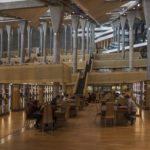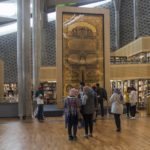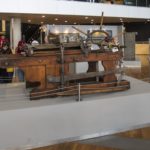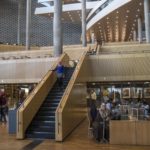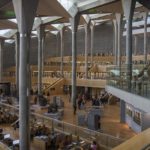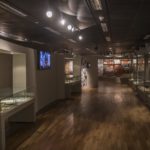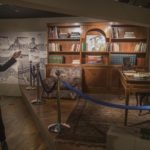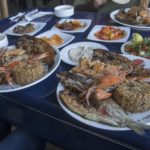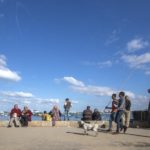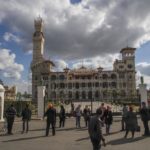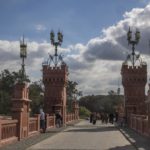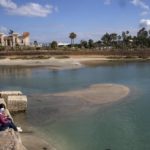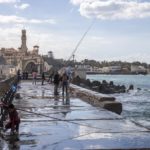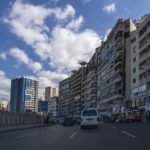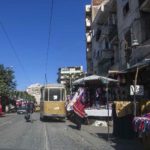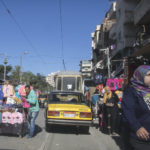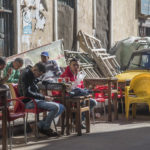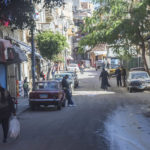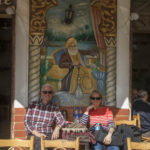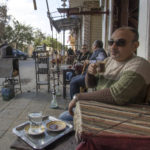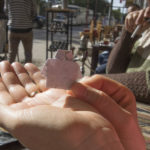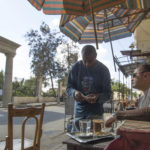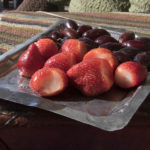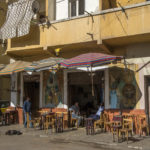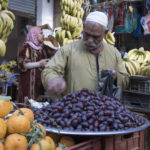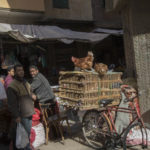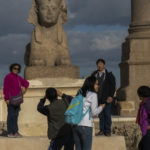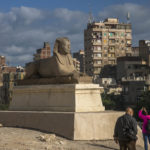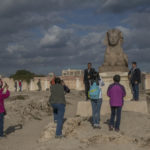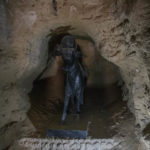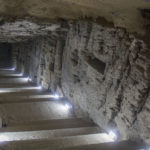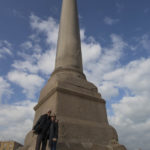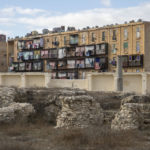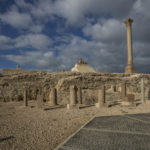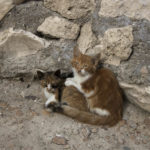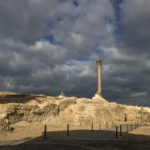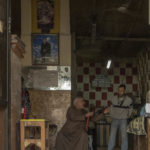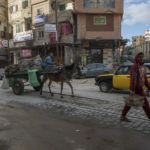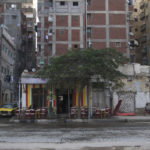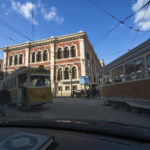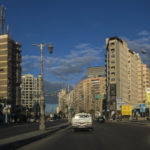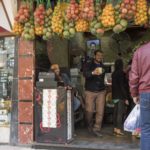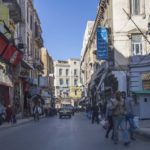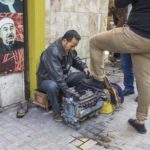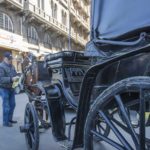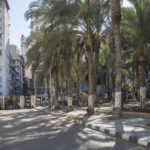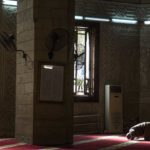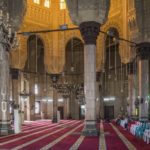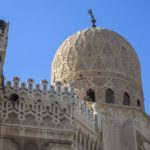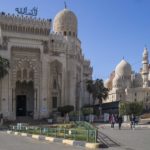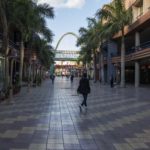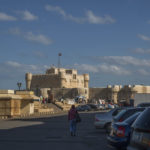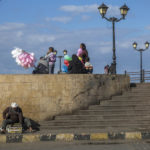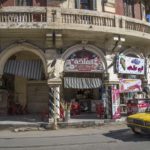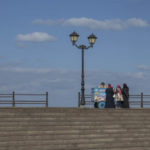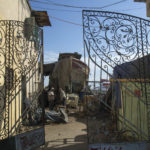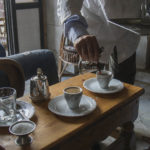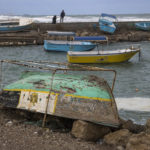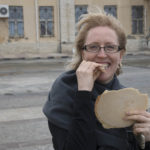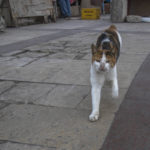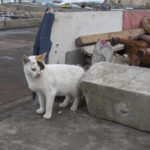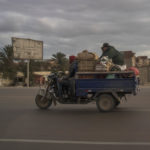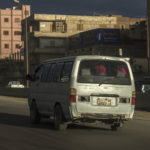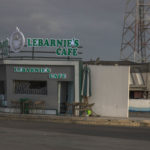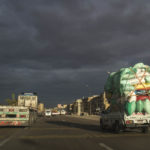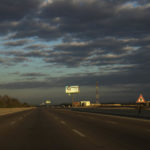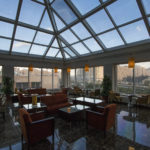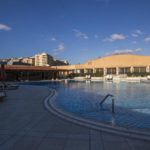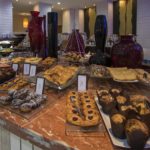Alexandria conjures romantic notions of the Ancient seaport of an Egypt ruled by Cleopatra, where the powerful nation did business with the rest of the Mediterranean and the world. While it is still the second most important city in the country and handles 80% of Egypt’s foreign trade, it is now more renowned as the seaside resort town that holiday-makers flock to every season (it’s population nearly triples at this time).
This city was our first destination on our first visit to Egypt. Arriving at 5:10am in a country is fabulous when you can breeze through immigration and the officer actually beams you a big smile instead of grumps at you. We paid $25USD each at the bank kiosk for a visa sticker to be put in the passport by the immigration officer, which was also a swift procedure.
As we left the terminal, there were men eager to assist, willing to be whoever we needed them to be to get work as drivers. One answered ‘yes’ to my ‘are you Ayman?’ but then gave up when I asked to see proof. We got out the doors of the arrivals terminal to an ocean of more drivers and a smiling man put his hand up behind the mass and called out ‘Nicole!’ – Yay! He found us!
Driving from Cairo to Alexandria
Bundled in our car, we high-tailed it out of there. It was 6am, and already the Cairo traffic was making its presence known. But luckily it didn’t take us too long to get onto the tollway and Ayman was fanging along with hardly any other vehicles on the road…just some foolhardy pedestrians who regularly sauntered across the highway, ignoring the overpasses! Apparently that is where accidents happen with pedestrians, not so in the cities where they just cross wherever they like in front of cars and miraculously don’t get hit.
Driving along these roads from Cairo to Alexandria was quite surreal. There were many areas of abandoned high-rise housing developments where the developers went bust when the bottom dropped out of the Egyptian pound. It looks like a post-apocalyptic film set…Mad Max, or something. And everything is covered in dusty sand, even the leaves of the trees and plants, not that there are many of those. When parking your car in a dusty lot, there was often the option of having it washed in your absence, but it seemed pointless.
Zipping through smaller towns along the highway, we noticed many mini apartment blocks with ‘reo’ poking out from the columns on their current top floor; “current” because the family who lives there will add a floor when a son or daughter marries. The whole building is inhabited by one extended family, and the fingers of steel await further additions to that little community. Family is very important in Egypt, one of the reasons being that there is no social security in the country. But despite this, there are very few homeless, and family takes care of family.
Ayman safely delivered us in Alexandria by 8:30am. Because we arrived at our hotel well before check in and also well before the shops opened (our hotel was located above a shopping mall), it took a little while to work out how to actually get into our hotel; both it and the shopping mall were surrounded by a huge brick and cement fence and finding the manned gate was interesting, but the obvious signs of security were reassuring. Although the 30 minute drive in traffic to the centre of Alexandria was not ideal, it was worth it to return to a haven with eager and friendly service from all staff (article on Hilton Alexandria Green Plaza).
Exploring the city
We dropped our luggage at the hotel and headed out to explore the city, under the tutelage of our driver and guide, Ayman. I found Ayman Ahmed on TripAdvisor and from the moment we met him we were drawn to his calm, wise and laid back presence with a dry sense of humour which was juxtaposed with a fierce intelligence and wealth of knowledge about all things Egyptian, current and ancient – a guide with a degree in archaeology is what you want in this venerable land. He already felt like our ‘habib’ (dear friend).
One of our first ‘Ayman lessons’ about Egypt was in understanding the way the day is broken up. People have breakfast at 5:30/6am, work from 7am-2pm (if in a government job, 7am to 5pm if in private industry), knock off and have lunch 2-4pm, then siesta from 6-8pm, “shopping or whatever” from 9-11pm, finishing with dinner at midnight or 1am (!!). I have no idea how they keep functioning throughout such a long day. But it was this life schedule that meant that the shops didn’t open until 11am, so when we arrived at the Green Plaza at 8:30am, it was like a ghost town.
So, Ayman took us to Alexandria’s seafront where we walked along the Corniche promenade in the bracing wind, finishing up at the Citadel of Qaitbay. Still being early, the stall owners and touters along the seawall were only just setting up their tables, and weren’t really expecting any trade at 9:30am. But they smiled and made a half-hearted attempt to sell us something. Ayman bought us some Egyptian sweets: two thin wafers the size of bread and butter plates stuck together with honey, as well as three versions of wafer sandwiches the diameter of a 20cent coin – one with coconut, one with peanuts and one with sesame seeds (the last two being stuck together with a toffee, caramel substance). Nothing like a sugar rush to keep you going after a 36 hour journey from Sydney to Alexandria.
Walking back towards the car, we continued to be buffeted by wind and eyed off by the stray cats that were cautiously nosing the air to see if we had any food they might be interested in. They didn’t get too close, though, clearly they were ‘shooed’ a lot.
Coffee House and Mosque
We stopped at a traditional coffee house for a natter and an authentic Egyptian experience. They love their coffee houses where they chat, smoke and drink coffee. It’s their down time, and they could sit there for an hour, easily, just shooting the breeze. And the ‘smoke’ isn’t just cigarettes, it’s a hooka pipe and hashish. “All the world’s troubles could be solved over coffee and a smoke together,” Ayman said, and laughed. True, they are certainly more chilled than most!
We visited Abu al-Abbas Mosque, the largest, most beautiful and historical mosque in Alexandria. Most of its structure dates from 1775 and was built over the tomb of a 13th century saint, but its current beautification happened in the 1940s. It is a regal and impressive building, its intricate and delicate carvings in gleaming white stone demanding attention and an intake of breath. John and Ayman entered from the front of the mosque (leaving their shoes with the shoe guard, who discreetly waited for a tip as they left). I had to enter from the side and stay behind the latticed screen where the women do their praying.
Falafels for lunch
From here, we went to Gad for lunch, the king of the falafel takeaway chain stores. Falafels in Egypt are made from fava beans rather than chickpeas, which make them much more moist, and delicious. These are put into pocket pita breads and eaten as a very convenient sandwich, often with a side of pickled vegetables. We knew we would be going to another Gad outlet as soon as the opportunity arose.
Wandered the streets for a while after our falafel sandwiches, taking in the atmosphere of our new city, doing some window shopping. We were completely stunned at the low cost of items such as leather wallets (the most expensive we saw was E£145 = $10AUD), quality leather belts, $6AUD, and leather jackets, $60AUD. Quality Egyptian cotton mens’ shirts were only $7AUD. But as we had only been in the country a few hours, our heads were not capable of making important shopping decisions beyond how many falafels to have in our pita pocket sandwich.
Driving in Alexandria
As we continued to walk and then drive with Ayman through the streets of Alexandria our tiredness increased, but so did our excitement at being in this new country. And it was such a wonderful learning experience having a local share his knowledge about customs and quirkiness. How is this for resourcefulness – there are scrap shops where you can buy a half a car from one shop and the other half from another shop, and build the thing yourself ‘at home’!! There are no road worthy laws in Egypt, so you can pretty much do what you want in regard to vehicles, which is quite scary considering how fast and crazily they drive here.
Finding our way on the tram-tracked streets, there was a moment on a corner with us stopped between two trams going in opposite directions and no-one going any where. A local cab tooted and exchanged loud and laughing words with Ayman, arms flailing in gesticulation – “just go with the tram!” They laughed and drove on. Not one ounce of the road rage of Australia.
Pompey’s Pillar and the Catacombs
Our second day in Alexandria began with a visit to Pompey’s Pillar (Amoud al-Sawary). Although this experience really began with us sitting in the coffee shop across the road from the site, Ayman having coffee, us hot chocolate. It was still early and we savoured the voyeuristic moments, watching the city waking and getting on with its day.
Refreshments downed, we wandered into the walled, ancient place, pausing for Ayman to greet the guard on duty – familiarity and friendliness, even when not ‘habibs’.
This site has been expanded over the last 10 years as they continue to excavate (and tear down houses and shops to do it) and discover more of these ancient ruins. The pillar was named by 19th century Europeans after the Roman consul, who was murdered in Egypt in 48 BC when seeking asylum. It stands 30m tall and was actually erected in 291 AD, and is the only freestanding column in Roman-Egypt that was not composed of drums. It is one of the largest monolithic columns ever erected.
Selfishly, the best bit of being there first thing in the morning was having the place to ourselves for half an hour before the tour buses arrived. The only company to be had was the stray cats, who placed themselves strategically in slanting patches in the sun to capture the rays. There were two ridiculously cute kittens curled up together in the sun against a low wall, trying to divest themselves of the chill of the cold night.
From there we went to the Catacombs of Kom es-Shoqafa, only a few blocks from Pompey’s Pillar. No photography was allowed at this venue, which meant we just had to listen more to the important information that Ayman shared about this anomaly in history. The weird thing about this place is that when archaeologists excavated they found absolutely no trace of any human remains, no fabric, bone, nothing. The tombs were empty. Even the sealed sarcophaguses, that have never been opened, are empty – which they know because of imaging equipment. The only remains at all that have been found are that of 27 horses, and really short horses at that. The paintings that decorate the tombs also make no sense – they are a “bad combination” of Egyptian, Greek and Roman representations of death; a real mishmash with errors and anomalies all over the place. Lots of questions are raised by these discoveries, but no answers have been found.
As a break from our morning wanderings, we bought some fresh fruit at a local market strawberries, dates and bananas, and took them to a coffee shop where the owner cut them up, washed them, and presented them on a platter. The dear man even re-washed them when we asked if they had been washed in bottled water (we don’t want a tummy-bug 24 hours into our Egyptian adventure!).
These strawberries were the most flavoursome I have ever eaten. Ayman said that everything is so fresh in Egypt that anything that the vendors didn’t sell on the day would be thrown away because no one will buy day old produce. Wow! Had never eaten fresh dates before either, only dried ones – also delicious, but the strawberries were my favourite. There was a smiling man working at this coffee place who was deaf and mute. We gave him our left over fruit, for which he was grateful, and he made me a little gift from a small rectangular piece of paper – he folded it into the shape of a man’s shirt. Made my day.
Royal Gardens, Montazah
We drove east along the coast to the Royal Gardens, Montazah. King Farouk imported trees and plants from Germany, Australia and New Zealand for these gardens, and as a result, they were very familiar to us.
The amusing point of the day was the McDonald’s Palace (yes, as in ‘the golden arches’!) – one of the three palaces in the gardens that McDonald’s purchased a year or so ago and are refurbishing. Hilarious! The actual impressively grand and ostentacious palace called Haramlik Palace (Montazah Palace) is not even used anymore. While there is some scaffolding on the outside to show it is not being allowed to fall into neglect, there is no public access. It makes no sense, though, as the interior is supposed to be magnificent, all gold leaf and such, and they could make a fortune by opening it to the public, but it’s a gigantic ‘no’ on this idea from the government, or military, not sure which.
Drove back along the car-darting, horn-tooting, Corniche, wondering at how this city of 4 million people expands to 11 million during summer. Clearly the currently empty hotels along the stretch would be chockas then, as well as every single centimetre of the beach!
Ayman took us to a local seafood restaurant, Sabrin Fish, where we ate like kings and paid like paupers. We had 7 side dishes and bread between the three of us, as well as a bowl of seafood soup and a dinner plate each full of mixed seafood (seabass, pippies, tempura prawns and crab) all for $9 AUD each, yes, $9!!! CRAY CRAY! This bargain is because Ayman insisted on paying the owner himself, and we had to make sure that no money changed hands between us and our ‘habib’ in public.
Biblioteca Alexandrina
The Biblioteca Alexandrina is a phenomenal building. What a venture!
“The city’s futuristic Bibliotecha Alexandrina resembles a giant discuss embedded in the ground, representing a second sun rising beside the Mediterranean. Pictograms, hieroglyphs and letters from every alphabet are carved on its exterior, evoking the diversity of knowledge embodied in the ancient library and the aspirations of the new one.” (Rough Guide, Egypt)
Cannot believe that some people, upon hearing we were going to visit this city, were like “Why bother with Alexandria?” – this building alone made it worth it! Loved that it is a multi-functional space that displays exhibitions as well. We only visited the ones that came with the price of the admission to the library, but still spent a good hour checking those out, mainly the Anwar Sadat exhibition. The range of old printing presses on display appears to be a permanent exhibition, which was an impressive collection.
You could easily spend a day exploring this extraordinary piece of architecture. From every tiered level you can see through the glassed, sloping roof to the sea – the light provided the allusion that one was outdoors, yet the warm, wooden surrounds and the silent compatriots cocooned the studious in a hushed haven, conducive to mental productivity.
The library was a mighty fine site to finish on, and sated from history, culture and feasting, we headed back to our hotel. No dinner was necessary, but a half-hearted attempt was made with beverages in the Executive Club Lounge at the Hilton Alexandria Green Plaza.
Our Egyptian journey continues with Cairo…
Accommodation: Hilton Alexandria Green Plaza
Tour Guide: Ayman Ahmed Tour Guide and TA Reviews
Click on any image below to view as gallery
- Quietly studying in the Bibliotecha Alexandrina
- Golden artwork in the Bibliotecha Alexandrina
- And old printing press on display of the landing of the Bibliotecha Alexandrina
- One of the many sets of stairs in the Bibliotecha Alexandrina
- Interior of the Bibliotecha Alexandrina
- Anwar Sadat Gallery, Bibliotecha Alexandrina
- Nic and a guide at the Anwar Sadat exhibition, Bibliotecha Alexandrina
- Our seafood feast, Alexandria
- Families enjoying the sun, Montazah, Alexandria
- King Farouk’s Palace at Montazah, Alexandria
- Bridge to the gardens at Montazah, Alexandria
- Inlet at Montazah, Alexandria
- Fishing spot at Montazah, Alexandria
- Driving along the Alexandria Corniche
- Tram in the street, Alexandria
- Vendors move their carts when the trams come through, Alexandria
- Drinking tea (the other favourite beverage) in Karmous, Alexandria
- A street in the Karmous Quarter of Alexandria
- John and Nic after their hot chocolates, Alexandria
- Ayman, enjoying his coffee, Alexandria
- Miniature paper shirt – a thank you for our donation of unwanted fresh fruit
- Kind man folding a ‘present’, Alexandria
- The tastiest strawberries on the planet, Alexandria
- Our second coffee shop of the day, Alexandria
- Fresh dates at the market, Alexandria
- Chickens at the market, Alexandria
- Photo op, Pompey’s Pillar, Alexandria
- History amongst the ‘Burbs, Alexandria
- The first busload of tourists has arrived, Pompey’s Pillar, Alexandria
- Copy of Apis Bull, Alexandria
- Optical illusion of descending stairs at Pompey’s Pillar, Alexandria
- John and Nic with Pompey’s Pillar, Alexandria
- Apartment buildings bordering the ancient site of Pompey’s Pillar, Alexandria
- Pompey’s Pillar miniature Sphynx, Alexandria
- Kittens getting warm in the cool, morning Egyptian air in Alexandria
- Pompey’s Pillar, Alexandria
- Imam chatting in the coffee shop, Alexandria
- Off to work in Alexandria
- Our morning coffee house, Alexandria
- Oncoming traffic, Alexandria
- Good morning, Alexandria
- Fruit juice, Alexandria
- Main street in the afternoon, Alexandria
- New arrivals in the shoe store, Alexandria
- Shoe shine in Alexandria
- Delicious Gad falafel in pita pocket
- Different kind of traffic jam in Alexandria
- Palm trees outside Abu al-Abbas Mosque, Alexandria
- Praying in Abu al-Abbas Mosque, Alexandria
- Interior of Abu al-Abbas Mosque, Alexandria
- Dome of Abu al-Abbas Mosque, Alexandria
- Abu al-Abbas Mosque, Alexandria
- Green Plaza shopping mall, Alexandria
- Morning light on the Citadel of Qaitbay, Alexandria
- The promenade in Alexandria
- Corner shop, Alexandria
- Ice cream, Alexandria
- Boatyard with fancy gates, Alexandria
- Coffee house, Alexandria
- Small boat harbour, Alexandria, Egypt
- Nic and her gigantic wafers, Alexandria
- “I can smell the food, human.” Alexandria, Egypt
- Stray amongst the rubble, Alexandria, Egypt
- A lift to work, Egypt
- Private bus service, Egypt
- LeBarnie’s Cafe, Egypt
- Morning light and grey clouds on the highway to Alexandria, Egypt
- Desert highway, Cairo to Alexandria, Egypt
- Executive Lounge of the Hilton Alexandria Green Plaza
- Rooftop pool of the Hilton Alexandria Green Plaza
- Breakfast pastries in the Executive Lounge of the Hilton Alexandria Green Plaza

